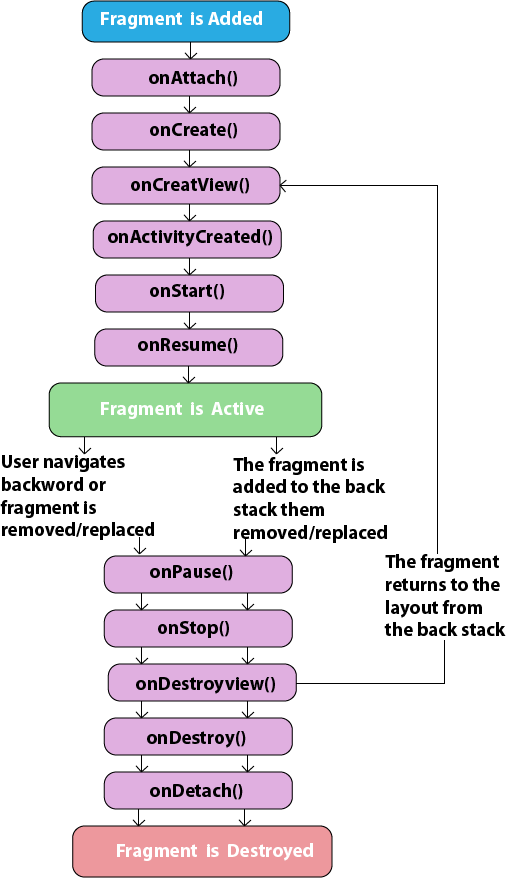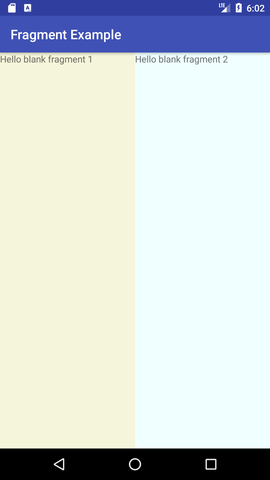本文概述
Android Fragment是活动的一部分,也称为子活动。一个活动中可以有多个片段。片段代表一个活动中的多个屏幕。
Android片段生命周期受活动生命周期的影响,因为片段包含在活动中。
每个片段都有自己的生命周期方法,这些方法受活动生命周期的影响,因为片段嵌入在活动中。
FragmentManager类负责在片段对象之间进行交互。
Android片段生命周期
android片段的生命周期就像活动的生命周期。片段有12种生命周期方法。

Android片段生命周期方法
| 没有。 | 方法 | 描述 |
|---|---|---|
| 1) | onAttach(活动) | 与活动相关联时, 它仅被调用一次。 |
| 2) | onCreate(捆绑) | 它用于初始化片段。 |
| 3) | onCreateView(LayoutInflater, ViewGroup, Bundle) | 创建并返回视图层次结构。 |
| 4) | onActivityCreated(捆绑销售) | 在onCreate()方法完成后调用它。 |
| 5) | onViewStateRestored(捆绑) | 它向片段提供有关片段视图层次结构的所有保存状态已还原的信息。 |
| 6) | onStart() | 使片段可见。 |
| 7) | onResume() | 使片段具有交互性。 |
| 8) | onPause() | 当片段不再互动时调用。 |
| 9) | onStop() | 当片段不再可见时调用。 |
| 10) | onDestroyView() | 允许片段清理资源。 |
| 11) | onDestroy() | 允许片段对片段状态进行最终清理。 |
| 12) | onDetach() | 在片段不再与其活动相关联之前立即调用它。 |
Android片段示例
让我们看一下android片段的简单示例。
activity_main.xml
<?xml version="1.0" encoding="utf-8"?>
<LinearLayout xmlns:android="http://schemas.android.com/apk/res/android"
xmlns:app="http://schemas.android.com/apk/res-auto"
xmlns:tools="http://schemas.android.com/tools"
android:layout_width="fill_parent"
android:layout_height="fill_parent"
tools:context="example.srcmini02.com.fragmentexample.MainActivity">
<fragment
android:id="@+id/fragment1"
android:name="example.srcmini02.com.fragmentexample.Fragment1"
android:layout_width="0px"
android:layout_height="match_parent"
android:layout_weight="1"
/>
<fragment
android:id="@+id/fragment2"
android:name="example.srcmini02.com.fragmentexample.Fragment2"
android:layout_width="0px"
android:layout_height="match_parent"
android:layout_weight="1"
/>
</LinearLayout><FrameLayout xmlns:android="http://schemas.android.com/apk/res/android"
xmlns:tools="http://schemas.android.com/tools"
android:layout_width="match_parent"
android:layout_height="match_parent"
android:background="#F5F5DC"
tools:context="example.srcmini02.com.fragmentexample.Fragment1">
<!-- TODO: Update blank fragment layout -->
<TextView
android:layout_width="match_parent"
android:layout_height="match_parent"
android:text="@string/hello_blank_fragment" />
</FrameLayout><FrameLayout xmlns:android="http://schemas.android.com/apk/res/android"
xmlns:tools="http://schemas.android.com/tools"
android:layout_width="match_parent"
android:layout_height="match_parent"
android:background="#F0FFFF"
tools:context="example.srcmini02.com.fragmentexample.Fragment2">
<!-- TODO: Update blank fragment layout -->
<TextView
android:layout_width="match_parent"
android:layout_height="match_parent"
android:text="@string/hello_blank_fragment" />
</FrameLayout>MainActivity类
package example.srcmini02.com.fragmentexample;
import android.support.v7.app.AppCompatActivity;
import android.os.Bundle;
public class MainActivity extends AppCompatActivity {
@Override
protected void onCreate(Bundle savedInstanceState) {
super.onCreate(savedInstanceState);
setContentView(R.layout.activity_main);
}
}package example.srcmini02.com.fragmentexample;
import android.os.Bundle;
import android.support.v4.app.Fragment;
import android.view.LayoutInflater;
import android.view.View;
import android.view.ViewGroup;
public class Fragment1 extends Fragment {
@Override
public void onCreate(Bundle savedInstanceState) {
super.onCreate(savedInstanceState);
}
@Override
public View onCreateView(LayoutInflater inflater, ViewGroup container, Bundle savedInstanceState) {
// Inflate the layout for this fragment
return inflater.inflate(R.layout.fragment_fragment1, container, false);
}
}package example.srcmini02.com.fragmentexample;
import android.os.Bundle;
import android.support.v4.app.Fragment;
import android.view.LayoutInflater;
import android.view.View;
import android.view.ViewGroup;
public class Fragment2 extends Fragment {
@Override
public void onCreate(Bundle savedInstanceState) {
super.onCreate(savedInstanceState);
}
@Override
public View onCreateView(LayoutInflater inflater, ViewGroup container, Bundle savedInstanceState) {
// Inflate the layout for this fragment
return inflater.inflate(R.layout.fragment_fragment2, container, false);
}
}输出:






